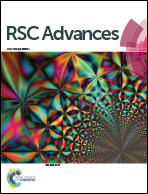Superior electrocatalytic activity of ultrathin PtPdBi nanowires towards ethanol electrooxidation†
Abstract
Bimetallic catalysts, PtBi, PtPd and PdBi have been explored and may be promising candidates for next-generation anodic catalysts of direct alcohol fuel cells due to their enhanced catalytic activity and long-term durability. However, ternary PtPdBi alloy catalysts are rarely reported because of the synthetic difficulty in manipulating three metallic precursors. Here, ternary metallic PtxPd93−xBi7 alloy nanowires were prepared for systematically investigating their electrocatalytic activity towards ethanol oxidation in basic solution by cyclic voltammetric and amperometric techniques. PtxPd93−xBi7 alloy nanowire, whether loaded on Vulcan XC72 carbon (C) or reduced graphene oxide (RGO), has better catalytic activity than PtPd, PtBi, PdBi, Pt/C, or Pd catalyst. Nevertheless, the catalytic activity of PtxPd93−xBi7 closely depends on the Pt : Pd atomic ratio. Pt55Pd38Bi7 alloy nanowire with the optimal Pt : Pd atomic ratio can produce the maximum enhancement towards ethanol electrooxidation. RGO replacing C as catalyst supporter can further improve the catalytic performance of catalyst. Pt55Pd38Bi7/RGO exhibits a superior catalytic performance, the mass activity of which reaches ∼3.60 A mg−1, ∼6 times better than commercial Pt/C.


 Please wait while we load your content...
Please wait while we load your content...